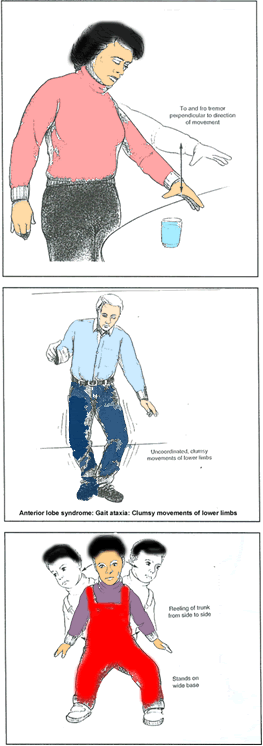| Clinical Anatomy | |
Cerebellar Lesions The general principle that pertain to most of the disturbances resulting from cerebellar lesions include the following:
|
|
a) Neocerebellar lesions are the best understood . These lesions affect primarily voluntary and associated movements (i.e. movements related to the corticospinal system). The symptoms/signs include the following: • Hypotonia : The tendon reflexes are diminished and the muscles are weak and flabby (asthenia) and also tire easily. • Asynergia : Severe disturbances of coordinated movements, in which the range, direction, and force of muscle contractions are inappropriate. Distances are frequently improperly gauged ( dysmetria ) and fall short of the mark or exceed it ( past-pointing ). • Tremors : These are intention tremors , because they are not present at rest. • Ataxia: It results in a bizarre distortion of voluntary and associated movements. It involves particularly the axial muscles, and groups of muscle around the shoulder and pelvic girdles. • Nystagmus : This disturbance consists of an oscillatory pattern in which the eyes slowly drift in one direction and then rapidly move in the opposite direction to correct the drift. • Speech disturbances : The speech syllables are unnaturally separated. There is slurring of speech, and some words are uttered in an explosive manner. • Archicerebellar lesions: These lesions involve mainly portions of the posterior cerebellar vermis (i.e. floculonodular lobe and the uvula, and constitute the archicerebellar syndrome . They produce disturbances of locomotion and equilibrium bilaterally thus: - The patient is unsteady in standing position and shows considerable swaying of the body. - On attempting to walk, there is staggering and a tendency to fall to one side or backwards - The gait is jerky, uncoordinated and resemble that of a drunken individual. - The muscle tone is not significantly altered, and no tremor or asynergic disturbances are seen in extremities.
|
|
 |
|